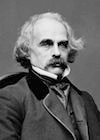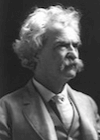Tom Swift and His War Tank
by Victor Appleton
Chapter XIII - Into a Trench
Tom cast a hasty glance over the mechanism of the machine before he started to cross the stream by the additional aid of the grippers, or spanners, as he sometimes called this latest device.
Along each side, in a row of sockets, were two long girders of steel, latticed like the main supports of a bridge. They were of peculiar triangular construction, designed to support heavy weights, and each end was broadly flanged to prevent its sinking too deeply into the earth on either side of a gully or a stream.
The grippers also had a sort of clawlike arrangement on either end, working on the principle of an "orange-peel" shovel, and these claws were designed to grip the earth to prevent slipping.
The spanners would be pulled out from their sockets on the side of the tank by means of steel cables, which were operated from within. They would be run out across the gap and fastened in place. The tank was designed to travel along them to the other side of the gap, and, once there, to pick up the girders, slip them back into place on the sides, and the engine of war would travel on.
"You are mightily excited, Tom.
"I admit it, Ned. You see, I have not tried the grippers out except on a small model. They worked there, but whether they will work in practice remains to be seen. Of course, at this stage, I'm willing to stake my all on the results, but there is always a half-question until the final try-out under practical conditions."
"Well, we'll soon see," said one of the workmen. "Are you ready, Mr. Swift?"
"All ready," answered Tom.
Tank A, as she was officially known, had come to a stop, as has been said, on the very edge of Tinkle Creek. The banks were fairly solid here, and descended precipitously to the water ten feet below. The shores were about twenty feet apart.
"Suppose the spanners break when you're halfway over, Tom?" asked his chum.
"I don't like to suppose anything of the sort. But if they do, we're going down!"
"Can you get up again?"
"That remains to be seen," was the non-committal reply. "Well, here goes, anyhow!"
Going up into the observation tower, which was only slightly raised above the roof of the highest part of the tank, Tom gave the signal for the motors to start. There was a trembling throughout the whole of the vast structure. Tom threw back a lever and Ned, peering from a side observation slot, beheld a strange sight.
Like the main arm of some great steam shovel, two long, latticed girders of steel shot out from the sides of the tank. They gave a half turn, as they were pulled forward by the steel ropes, so that they lay with their broader surfaces uppermost.
Straight across the stream they were pulled, their clawlike ends coming to a rest on the opposite bank. Then they were tightened into place by a backward pull on the operating cables, and Tom, with a sigh of relief, announced:
"Well, so far so good!"
"Do we go over now?" inquired Ned.
"Over the top—yes, I hope," answered Tom, with a laugh. "How about you down there?" he called to the engine room through a telephone which could only be used when the machinery was not in action, there being too much noise to permit the use of any but visual signals after that.
"All right," came back the answer. "We're ready when you are."
"Then here we go!" said Tom. "Hold fast, Ned! Of course there's no real telling what will happen, though I believe we'll come out of it alive."
"Cheerful prospect," murmured Ned.
The grippers were now in place. It only remained for the tank to propel herself over them, pick them up on the other side of Tinkle Creek, and proceed on her course.
Tom Swift hesitated a moment, one hand on the starting lever and the other on the steering wheel. Then, with a glance at Ned, half whimsical and half resolute, Tom started Tank A on what might prove to be her last journey.
Slowly the ponderous caterpillar belts moved around on the sprocket wheels. They ground with a clash of steel on the surface of the spanners. So long was the tank that the forward end, or the "nose," was halfway across the stream before the bottom part of the endless belts gripped the latticed bridge.
"If we fall, we'll span the creek, not fall into it," murmured Ned, as he looked from the observation slot.
"That's what I counted on," Tom said. "We'll get out, even if we do fall."
But Tank A was not destined to fall. In another moment her entire weight rested on the novel and transportable bridge Tom Swift had evolved. Then, as the gripping ends of the girders sank farther into the soil, the tank went on her way.
Slowly, at half speed, she crawled over the steel beams, making progress over the creek and as safely above the water as though on a regularly constructed bridge.
On and on she went. Now her entire weight was over the middle of the temporary structures. If they were going to give way at all, it would be at this point. But they did not give. The latticed and triangular steel, than which there is no stronger form of construction, held up the immense weight of Tank A, and on this novel bridge she propelled herself across Tinkle Creek.
"Well, the worst is over," remarked Ned, as he saw the nose of the tank project beyond the farthermost bank.
"Yes, even if they collapse now nothing much can happen," Tom answered. "It won't be any worse than wallowing down into a trench and out again. But I think the spanners will hold."
And hold they did! They held, giving way not a fraction of an inch, until the tank was safely across, and then, after a little delay, due to a jamming of one of the recovery cables, the spanners were picked up, slid into the receiving sockets, and the great war engine was ready to proceed again.
"Hurrah!" cried Ned. "She did it, Tom, old man!" and he clapped his chum resoundingly on the back.
"She certainly did!" was the answer. "But you needn't knock me apart telling me that. Go easy!"
"Bless my apple pie!" cried Mr. Damon, who was as much pleased as either of the boys, "this is what I call great!"
"Yes, she did all that I could have hoped for," said Tom. "Now for the next test."
"Bless my collar button! is there another?"
"Just down into a trench and out again." Tom said. "This is comparatively simple. It's only what she'll have to do every day in Flanders."
The tank waddled on. A duck's sidewise walk is about the only kind of motion that can be compared to it. The going was easier now, for it was across a big field, and Tom told his friends that at the other end was a deep, steep and rocky ravine in which he had decided to give the tank another test.
"We'll imagine that ravine is a trench," he said, "and that we've got to get on the other side of it. Of course, we won't be under fire, as the tanks will be at the front, but aside from that the test will be just as severe."
A little later Tank A brought her occupants to the edge of the "trench."
"Now, little girl," cried Tom exultingly, patting the rough steel side of his tank, "show them what you can do!"
"Bless my plum pudding!" cried Mr. Damon, "are you really going down there, Tom Swift?"
"I am," answered the young inventor. "It won't be dangerous. We'll crawl down and crawl out. Hold fast!"
He steered the machine straight for the edge of the ravine, and as the nose slipped over and the broad steel belts bit into the earth the tank tilted downward at a sickening angle.
She appeared to be making the descent safely, when there was a sudden change. The earth seemed to slip out from under the broad caterpillar belts, and then the tank moved more rapidly.
"Tom, we're turning over!" shouted Ned. "We're capsizing!"
Return to the Tom Swift and His War Tank Summary Return to the Victor Appleton Library









